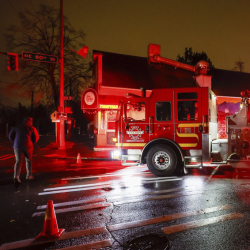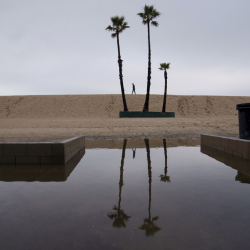"So the concept is this basically: The whole Black nation has to be put together as a Black army. And we gon' walk on this nation. We gon' walk on the racist power structure. And we gone say to the government: "Stick em' up motherf****r, this is a holdup. We've come for what's ours"—excerpt from the 1995 DVD "What We Want, What We Believe" the Black Panther Party Library.
It's been more than three decades since the collapse of the Black Panther Party (for Self Defense), as it was originally titled. After a historic campaign of militant demonstration and persisting community activism, the grassroots alliance that was, as FBI Director J. Edgar Hoover described, "the greatest threat to the internal security of the country," finally crumbled under the relentless pressure of external opposition in 1970.
"Do you want to know why we aren't still around like the NAACP and all those other Uncle Tom Negroes?" asked Roland Freeman, former leader of the Panther's Los Angeles Chapter. "It's because we didn't want integration, we wanted progress, and integration aint' progress. We wanted our communities to be self-sufficient, self-aware and armed. Not walking hand and hand with the enemy."
Freeman added that Huey Newton, the Panther's founding member, went public with his decision to disband every segment of the party, without informing with his estranged brethren.
"He didn't tell us nothing [Newton]," griped Roland Freeman, former leader of the Panther's Los Angeles Chapter. "From what I knew, we were supposed to establish a new extension underground in Dallas, Texas, because things were getting too heated on the streets. But, that never happened."
Newton's knee-jerk reaction to the government's ever-looming presence, prompted other key members of the panthers to break ranks, in an attempt to establish their own power base.
"When the split came, all the comrades (who) were revolutionary in their ideals and admirations for the Black Panther Party were on one side; and the other side with Newton and Hilliard represented the dictatorial power," former field marshal of the panthers Donald L. Cox said in an interview in the What We Want DVD. "[Newton's way was] you do what I say or you're going to get your head knocked in. That was the split."
A number of Panther leaders, including Newton and chief of staff David Hilliard, turned their focus to community service as well as self-defense, while former minister of information for the Panthers, (Leroy) Eldridge Cleaver, and others, embraced a more confrontational strategy.
Cleaver's faction proceeded to buck the powers that be—namely police, or "pigs" and they were often tagged by this splinter Panther group—with streaks of arbitrary violence and engaged indiscriminate battles with rival organizations.
Cleaver's rash approach to Black justice culminated with the death of Panther Bobby Hutton, or "Lil Bobby," the party's treasurer, who was gunned down during a haphazard ambush attempt on the Oakland Police by Cleaver's fraction of the party in 1968. The strain between he and Newton grew more severe when he publicly criticized his estranged comrade for adopting a "reformist" rather than "revolutionary" agenda, and he also called for Hilliard's permanent removal.
As a result, Cleaver was expelled from the Panther central committee but went on to lead a splinter group called the Black Liberation Army, which had previously existed as an underground paramilitary wing of the Party. Both factions eventually deteriorated due to rising legal costs and perpetual infighting with the individual groups. The demise was aided by steady doses of calculated interference by the FBI and other government agencies.
Throughout 1969, the Black Panthers were the primary target of the FBI's Counter Intelligence Program COINTELPRO, designed to neutralize, and ultimately terminate, the more prominent Black Nationalist organizations. The secondary aim was to prevent the unification of these groups, while also weakening the power of their leaders, which, in turn, would reduce their support and growth, according to the What We Want DVD.
Consequentially, many established Panther chapters across the U.S. collectively experienced more than 233 government-authorized sieges as well as raids by numerous COINTERLPRO agents. As a result they were extensively weakened.
Other intended targets of the government covert action program include the Southern Christian Leadership Conference, the Student Nonviolent Coordinating Committee, the Revolutionary Action Movement, and the Nation of Islam.
In 1974, Newton appointed veteran member Elaine Brown as the first woman to chair the Panthers. Under Brown's leadership, the party became involved in organizing for more radical electoral campaigns, including Brown's unsuccessful run for Oakland City Council in 1975, and Lionel Wilson's successful election as the first Black mayor of Oakland.
Certain aspects of COINTELPRO were directed at creating and exploiting existing rivalries between Black nationalist factions. One such attempt was to "intensify the degree of animosity" between the Black Panthers and the Blackstone Rangers, a Chicago street gang.
In Southern California, similar actions were taken to exacerbate conflict between the Black Panther Party and a group called the US Organization. Violent conflict between these two groups, including shootings and beatings, led to the deaths of at least four Black Panther Party members, according to Jessica Christina Harris in the Journal of Negro History.
On January 17, 1969, Los Angeles Panther Captain Bunchy Carter and Deputy Minister John Huggins were killed in Campbell Hall on the UCLA campus, in a gun battle with members of US Organization, stemming from a dispute over who would control UCLA's Black studies program. Another shootout between the two groups on March 17 led to further injuries. It was alleged that the FBI had sent a provocative letter to US Organization in an attempt to create antagonism between US and the Panthers.
While a sizable part of the organization was already participating in local government and social services, others were in constant conflict with the police. For some of the Party's supporters, the lines between political action, criminal activity, social opportunity, access to sustainable power, and grassroots identity became blurred, as were the intentions of certain Panther organizers, Cleaver and Newton being among them.
Portland and Seattle
Free Subscription to Breaking News
Free Subscription to Breaking News




















































































































































































































































































































































